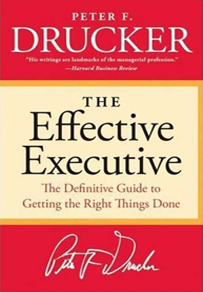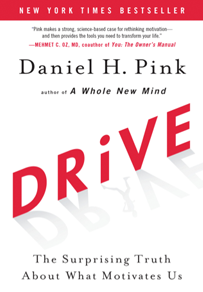Suggested Reading
Browse by Subject
-
The Effective Executive
The Definitive Guide to Getting the Right Things Done
by Peter Drucker
There are hundreds of books on the topic of executive effectiveness, but there have been very few things said in the interim that Peter Drucker hadn't already figured out in the 1960s. What makes an effective executive? The measure of the executive, Drucker reminds us, is the ability to "get the right things done." This usually involves doing what other people have overlooked as well as avoiding what is unproductive. Drucker identifies five practices essential to business effectiveness that can, and must, be learned: managing time, choosing what to contribute to the organization, knowing where and how to mobilize strength for best effect, setting the right priorities, and tying all of them together with effective decision-making. When you reduce his ideas down, they seem obvious. But it took this teacher of wisdom to combine these insights into a book.
-
Leadership is an Art
by Max De Pree
Leadership is an Art says more about leadership in clearer, more elegant, and more convincing language than many of the much longer books that have been published on the subject. De Pree looks at leadership as a kind of stewardship, stressing the importance of building relationships, initiating ideas, and creating a lasting value system within an organization. Rather than focusing on the “hows” of leadership, he explains the “whys.” He shows that the first responsibility of a leader is to define reality and the last is to say thank you. Along the way, the artful leader must: stimulate effectiveness by enabling others to reach both their highest potential; take a role in developing, expressing, and defending values; nurture new leaders; and ensure the continuation of the corporate culture. This is a must-read on the topic of leadership and business management.
-
First, Break All the Rules
What the World's Greatest Managers Do Differently
by Marcus Buckingham and Curt Coffman
No matter how generous its pay or how renowned its training, the company that lacks effective managers will suffer. But the most effective managers seem to have little in common. They differ in sex, age, and race. They employ vastly different styles and focus on different goals. Yet despite their differences, great managers share one common trait: They do not hesitate to break virtually every rule held sacred by conventional wisdom. Marcus Buckingham and Curt Coffman of the Gallup Organization present the findings of their study of great managers across organizations of all types and sizes. Whatever their situations, the managers who ultimately became the focus of Gallup's research were invariably those who excelled at turning each employee's talent into performance. This book has important lessons for managers at every level of an organization.
-
The Goal
A Process of Ongoing Improvement
by EliyahuGoldratt and Jeff Cox
The Goal is a story that revolves around saving a manufacturing plant, but the principles used to save it apply to every industry and every kind of business. The Goal contains an important insight, the Theory of Constraints. The theory says that every system, no matter how well it performs, has at least one constraint that limits its performance – this is the system's "weakest link." These are where bottlenecks occur that prevent an organization from maximizing its performance and reaching its goals. Constraints can involve people, supplies, information, equipment, or even policies, and they can be internal or external to an organization. A leader must continually focus on identifying and unlocking the primary constraint of the business. The Goal is a must-have book for any leader with a serious desire to drive real, organizational improvement and change.
-
Switch
How To Change When Change Is Hard
by Chip Heath and Dan Heath
Switch is about making change happen, despite our tendency to fight it. Change management traditionally focuses on process. But the authors of Made to Stick combine psychology, sociology, management, and case studies, to tell stories of people and organizations who have successfully implemented significant changes—even when change is hard. The Heaths show that some of the most transformative managers follow a pattern of change. They argue that the trick to making things happen quickly on a large scale is to sync emotional thinking with rationale thinking. Switch is an entertaining read and makes its points with humor and diverting anecdotes.
-
Multipliers
How the Best Leaders Make Everyone Smarter
by Liz Wiseman and Greg McKeown
Multipliers delivers a thought-provoking assessment of why some leaders drain capability and intelligence from their teams while others amplify it to produce better results. “Multipliers" are leaders who use their intelligence to amplify the intelligence and capabilities of the people around them. On the other hand, “diminishers" are the idea killers, the energy sappers, the diminishers of talent and commitment. Multipliers can have a positive and profitable effect on organizations—getting more done with fewer resources, developing and attracting top talent, and cultivating new ideas and energy by accessing all the intelligence that sits inside their organizations.
-
Influence
The Psychology of Persuasion
by Robert Cialdini,
Persuasion is at the heart of business, where leaders must reach customers, clients, employees, and suppliers. Influence is a classic book on the core principals of persuasion and is a great example of how psychological principles apply to the business world. You'll learn the six universal principles of ethical persuasion: reciprocity, commitment and consistency, social proof, liking, authority, and scarcity. Cialdini shows how to use the principles to become a skilled persuader—and how to defend yourself against them. Based on research and interviews — with a wide range of top persuaders—Cialdini explains the psychology behind what moves people to say “yes” and how to translatethis information into the real world.
-
Built to Last
Successful Habits of Visionary Companies
by Jim Collins and Jerry Porras
“Built to Last” is one of the most influential business books of our time. Jim Collins and Jerry Porras, identified what makes visionary companies – ones that beat consistently beat their competitors, withstand changes in the marketplace, make a significant impact on the world and have outperformed the stock market by 15 times since 1926. The authors conclude that a visionary company is not contingent on one brilliant CEO, but on elements that transcend any individual leader. Companies such as Boeing, Walt Disney, Nordstrom, Wall-Mart and General Electric share fundamental characteristics that distinguish them from less visionary companies, such as: preserving a fixed core ideology, yet having the ability to adapt; going beyond culture to embrace "cultism"; creating what the authors call BHAGs (big, hairy, audacious goals); mimicking the biological evolution of the species; and having a strong sense of purpose beyond making money.
-
Drive
The Surprising Truth About What Motivates Us
by Daniel Pink
The way we structure organizations almost always assumes that the prospect of greater financial reward is the primary factor in human motivation. That’s a mistake, Dan Pink says in “Drive.” Drawing on four decades of scientific research on human motivation, Pink reveals the gap between what science knows and what business does—and how it affects performance. Pink argues that while the old-fashioned carrot-and-stick approach worked successfully in the 20th century, it's the "wrong" way to motivate people for today's challenges. In “Drive,” Pink contends that it’s important for organizations to pay people fairly, but then they must focus on the three elements of true motivation—autonomy, mastery, and purpose. Throughout the book, Pink offers techniques for putting these elements into action to unleash peoples’ inner drive and provides plenty of examples of companies that are taking new approaches to motivation. “Drive” is a great book for helping leaders, at all levels, understand motivation in today’s world.
-
Playing to Win
How Strategy Really Works
by A.G. Lafley and Roger Martin
Are you just playing—or playing to win? Strategy is not complex. But it is hard. It's hard because it forces people and organizations to make specific choices about their future—something that doesn't happen in most companies. “Playing to Win” shows how leaders in organizations of all sizes can guide everyday actions with larger strategic goals built around the clear, essential elements that determine business success—where to play and how to win. Lafley and Martin have created a set of five essential strategic choices that, when addressed in an integrated way, will move you ahead of your competitors. They are: (1) What is our winning aspiration? (2) Where will we play? (3) How will we win? (4) What capabilities must we have in place to win? (5) What management systems are required to support our choices? The stories of how Proctor & Gamble repeatedly won by applying this method to iconic brands such as Bounty, Gillette, Swiffer, and Febreze clearly illustrate how deciding on a strategic approach—and then making the right choices to support it—makes the difference between just playing the game and actually winning. ”Playing to Win” will help leaders at all types and sizes of companies to become more effective, courageous and creative.












